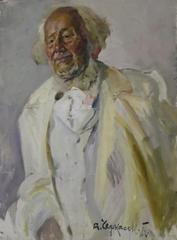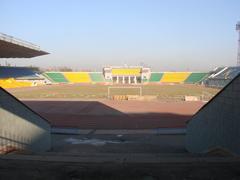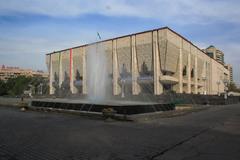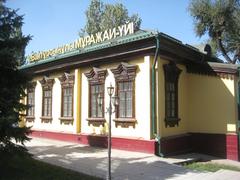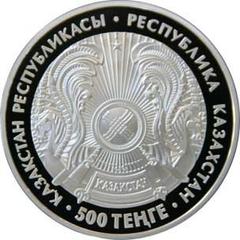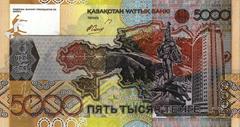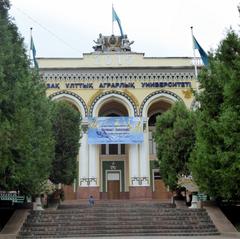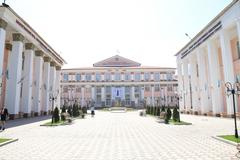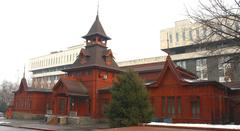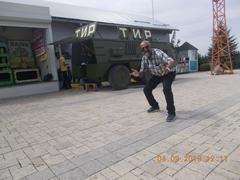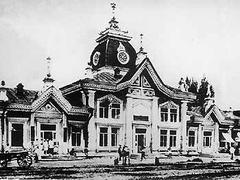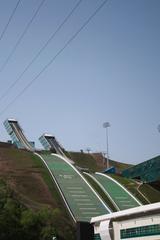Church Of The Icon Of The Mother Of God 'Joy Of All Who Sorrow'
Church of the Icon of the Mother of God “Joy of All Who Sorrow” in Almaty, Kazakhstan: Visiting Hours, Tickets, and Historical Significance
Date: 04/07/2025
Introduction
Nestled in the vibrant city of Almaty, Kazakhstan, the Church of the Icon of the Mother of God “Joy of All Who Sorrow” stands as a profound testament to the enduring legacy of Orthodox Christianity in Central Asia. This sacred site provides a window into centuries-old spiritual traditions while serving as a cultural beacon reflecting Kazakhstan’s rich religious and historical tapestry. For visitors, the church offers an immersive experience—blending Russian Byzantine architectural beauty, intricate iconography, and deep community devotion that encapsulate the Orthodox faith’s resilience in the region.
Orthodoxy’s presence in Kazakhstan dates back to early Silk Road exchanges and strengthened significantly during the Russian imperial expansion of the 18th and 19th centuries. Despite enduring severe repression in the Soviet era, the faith experienced a vibrant revival after Kazakhstan’s independence in 1991. The Church of the Icon of the Mother of God “Joy of All Who Sorrow” stands at the heart of this renaissance, offering spiritual solace and hosting the venerated icon known for miraculous healings and compassionate intercession (True Orthodox Diocese of Western Europe; Holy Transfiguration).
This comprehensive guide explores the church’s historical background, theological importance, architectural highlights, and practical visitor information. Whether attending a liturgical service, exploring the church’s artistic heritage, or seeking quiet reflection, visitors will find an enriching experience that connects the spiritual and cultural threads of Kazakhstan’s Orthodox community. Details on guided tours, etiquette, and community events are provided to help make the most of your visit (Orthodox Church in America).
Table of Contents
- Introduction
- Historical Development of Orthodoxy in Kazakhstan
- The Role and Significance of Orthodoxy in Kazakhstan
- About the Church of the Icon of the Mother of God “Joy of All Who Sorrow”
- Practical Visitor Information
- Joy of All Who Sorrow Icon: History and Significance
- Visiting the Church: Practical Guide
- Visuals and Media
- Explore More: Related Almaty Sites
- Conclusion
- References
Historical Development of Orthodoxy in Kazakhstan
Early Christian Presence and Tsarist Expansion
Christianity first appeared in Kazakhstan through early Silk Road trade, with Nestorian Christian communities emerging along key routes. These communities faded before Russian imperial expansion in the 18th and 19th centuries established Orthodoxy anew, primarily through settlers and the military. The Eparchy of Turkestan, established in 1871, laid the institutional foundation for Orthodoxy, which expanded as the population grew.
Soviet Era: Suppression and Survival
The Soviet period brought intense suppression: churches were closed or repurposed, and public worship was restricted. Despite these challenges, private religious practice endured. In 1945, the Eparchy of Almaty and Kazakhstan was established, signaling a slow revival of religious life.
Post-Soviet Revival and Modern Developments
With Kazakhstan’s independence in 1991, Orthodoxy experienced renewal. Churches were restored, seminaries reopened, and Orthodox Christmas (January 7) became a national holiday. Visits by Patriarch Alex II and Patriarch Kirill further affirmed Orthodoxy’s role in Kazakhstan’s interfaith landscape.
The Role and Significance of Orthodoxy in Kazakhstan
Demographics and Community
Orthodox Christianity is Kazakhstan’s second-largest religion, practiced mainly by ethnic Russians, Ukrainians, Belarusians, and some Kazakhs. As of 2025, at least 15 officially recognized Orthodox churches serve communities in cities such as Almaty, Astana, Karaganda, and Pavlodar.
Cultural and Social Influence
Orthodox churches act as centers for worship, cultural preservation, education, and charity. The celebration of Orthodox holidays and engagement in social projects highlight Kazakhstan’s religious pluralism.
Architectural and Artistic Heritage
Kazakhstan’s Orthodox churches, including the Church of the Icon of the Mother of God “Joy of All Who Sorrow,” exhibit Russian Byzantine architecture with golden domes, frescoes, and richly decorated iconostases. Notable examples include the Holy Ascension Cathedral and the Cathedral of Christ the Saviour.
About the Church of the Icon of the Mother of God “Joy of All Who Sorrow”
Spiritual and Community Role
The church in Almaty is a cherished spiritual center, following the Russian Orthodox liturgical calendar and hosting regular services, feast days, and sacraments. The “Joy of All Who Sorrow” icon is central to parish life, revered as a source of comfort and healing.
Integration in Kazakhstan’s Religious Landscape
This church exemplifies Kazakhstan’s religious harmony, participating in interfaith events and receiving state recognition as part of the nation’s traditional religious fabric.
Practical Visitor Information
Visiting Hours and Tickets
- Hours: Generally open daily from 9:00 AM to 6:00 PM, with variations on feast days and special events.
- Tickets: Admission is free; donations are welcome to support the church’s upkeep and programs.
- Guided Tours: Available by appointment and through local tourist agencies, including Russian and English options.
Accessibility
The church provides ramps and accessible restrooms for visitors with limited mobility. Contact the church ahead of time to confirm specific accessibility needs.
Dress Code and Etiquette
- Dress: Modest attire required. Women are encouraged to cover their heads; men should remove hats.
- Etiquette: Photography is allowed outside; permission is needed inside, especially during services. Maintain a respectful demeanor, silence mobile devices, and avoid loud conversation.
Location and Nearby Attractions
Located in central Almaty, the church is accessible by public transport, taxi, and on foot. It is close to Ascension Cathedral, Panfilov Park, and other historical landmarks. Cafés, restaurants, and shops nearby offer local cuisine and souvenirs, including religious articles.
Joy of All Who Sorrow Icon: History and Significance
Historical Origins
The icon’s veneration began in 17th-century Russia, following the miraculous healing of Euphrosyne in 1688 (True Orthodox Diocese of Western Europe). Its reputation as a source of comfort and healing spread, leading to the dedication of numerous churches—including the one in Almaty.
Iconographic Symbolism
The icon typically depicts the Mother of God in the center, often holding Christ, surrounded by angels and supplicants in distress (Catalog of Good Deeds). The colors and arrangement symbolize compassion, hope, and divine intercession.
Theological and Liturgical Role
The icon embodies the Theotokos’s role as a compassionate intercessor. October 24 (November 6 Gregorian) is the main feast day, marked by special services and processions.
Pilgrimage and Miraculous Accounts
Pilgrims visit the church seeking spiritual and physical healing. Accounts of miracles and comfort through prayer before the icon remain central to its appeal.
Visiting the Church: Practical Guide
- Address: Centrally located in Almaty (check current maps for details).
- Opening Hours: 9:00 AM – 6:00 PM daily; extended on feast days.
- Admission: Free, with donations appreciated.
- Guided Tours: Arrange in advance for English-speaking guides.
- Accessibility: Ramps and accessible restrooms; contact in advance for details.
- Dress Code: Modest; women cover heads, men remove hats.
- Photography: Allowed outside; permission required inside.
- Nearby Sites: Ascension Cathedral, Panfilov Park, Central State Museum.
Visuals and Media
Enhance your visit by exploring high-quality photos and virtual tours available on tourism websites. Look for images highlighting the church’s domes, iconostasis, and frescoes.
Explore More: Related Almaty Sites
While in Almaty, consider visiting the Zenkov Cathedral, Central State Museum, and Panfilov Park. Refer to local tourism platforms or the Audiala app for comprehensive guides and maps.
Conclusion
The Church of the Icon of the Mother of God “Joy of All Who Sorrow” is a living sanctuary where faith, culture, and community converge. Its rich history—from the icon’s miraculous origins in Russia to its pivotal role in Kazakhstan’s Orthodox revival—continues to inspire visitors. The church’s architecture, adorned with frescoes and an impressive iconostasis, invites all to experience its sacred ambiance.
Visitors benefit from free admission, accessibility features, and guided tours. The church’s central location allows easy access to other Almaty landmarks. Community outreach and the preservation of Orthodox traditions underscore its vital role in Kazakhstan’s diverse religious landscape.
Plan your visit by checking current hours, observing dress codes, and considering guided tours. Engage with the church during feast days, especially the celebration of the “Joy of All Who Sorrow” icon. This church remains an essential destination for anyone interested in the spiritual heritage and historical depth of Almaty and Kazakhstan.
Download the Audiala app for guided tours and the latest information. Stay connected with the Orthodox community and discover more about Kazakhstan’s historical sites.
